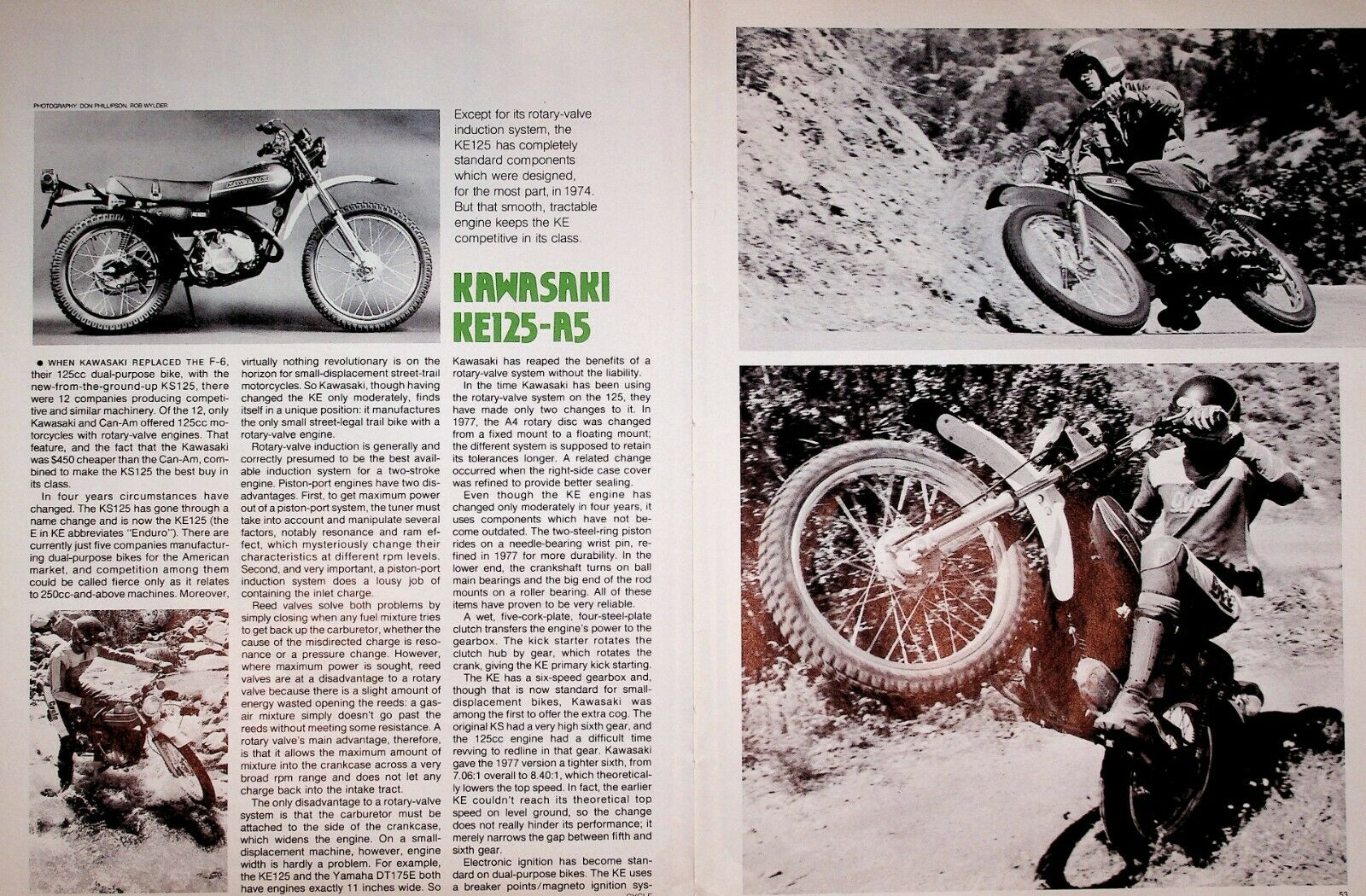-40%
1978 Kawasaki KE125-A5 - 5-Page Vintage Motorcycle Road Test Article
$ 8.84
- Description
- Size Guide
Description
1978 Kawasaki KE125-A5 - 5-Page Vintage Motorcycle Road Test ArticleOriginal, vintage magazine article
Page Size: Approx. 8" x 11" (21 cm x 28 cm) each page
Condition: Good
WHEN KAWASAKI REPLACED THE F-6,
their 125cc dual-purpose bike, with the
new-from-the-ground-up KS125, there
were 12 companies producing competi-
tive and similar machinery. Of the 12, only
Kawasaki and Can-Am offered 125cc mo-
torcycles with rotary-valve engines. That
feature, and the fact that the Kawasaki
was S450 cheaper than the Can-Am, com-
bined to make the KS125 the best buy in
its class.
In four years circumstances have
changed. The KS125 has gone through a
name change and is now the KE125 (the
E in KE abbreviates “Enduro"). There are
currently just five companies manufactur-
ing dual-purpose bikes for the American
market, and competition among them
could be called fierce only as it relates
to 250cc-and-above machines. Moreover,
virtually nothing revolutionary is on the
horizon for small-displacement street-trail
motorcycles. So Kawasaki, though having
changed the KE only moderately, finds
itself in a unique position: it manufactures
the only small street-legal trail bike with a
rotary-valve engine.
Rotary-valve induction is generally and
correctly presumed to be the best avail-
able induction system for a two-stroke
engine. Piston-port engines have two dis-
advantages. First, to get maximum power
out of a piston-port system, the tuner must
take into account and manipulate several
factors, notably resonance and ram ef-
fect, which mysteriously change their
characteristics at different rpm levels.
Second, and very important, a piston-port
induction system does a lousy job of
containing the inlet charge.
Reed valves solve both problems by
simply closing when any fuel mixture tries
to get back up the carburetor, whether the
cause of the misdirected charge is reso-
nance or a pressure change. However,
where maximum power is sought, reed
valves are at a disadvantage to a rotary
valve because there is a slight amount of
energy wasted opening the reeds: a gas-
air mixture simply doesn’t go past the
reeds without meeting some resistance. A
rotary valve's main advantage, therefore,
is that it allows the maximum amount of
mixture into the crankcase across a very
broad rpm range and does not let any
charge back into the intake tract.
The only disadvantage to a rotary-valve
system is that the carburetor must be
attached to the side of the crankcase,
which widens the engine. On a small-
displacement machine, however, engine
width is hardly a problem. For example,
the KE125 and the Yamaha DT175E both
have engines exactly 11 inches wide. So
Except for its rotary-valve
induction system, the
KE125 has completely
standard components
which were designed,
for the most part, in 1974.
But that smooth, tractable
engine keeps the KE
competitive in its class.
KRHR5RKI
KE125-R5
Kawasaki has reaped the benefits of a
rotary-valve system without the liability.
In the time Kawasaki has been using
the rotary-valve system on the 125, they
have made only two changes to it. In
1977, the A4 rotary disc was changed
from a fixed mount to a floating mount;
the different system is supposed to retain
its tolerances longer. A related change
occurred when the right-side case cover
was refined to provide better sealing.
Even though the KE engine has
changed only moderately in four years, it
uses components which have not be-
come outdated. The two-steel-ring piston
rides on a needle-bearing wrist pin, re-
fined in 1977 for more durability. In the
lower end, the crankshaft turns on ball
main bearings and the big end of the rod
mounts on a roller bearing. All of these
items have proven to be very reliable.
A wet, five-cork-plate, four-steel-plate
clutch transfers the engine's power to the
gearbox. The kick starter rotates the
clutch hub by gear, which rotates the
crank, giving the KE primary kick starting.
The KE has a six-speed gearbox and,
though that is now standard for small-
displacement bikes, Kawasaki was
among the first to offer the extra cog. The
original KS had a very high sixth gear, and
the 125cc engine had a difficult time
revving to redline in that gear. Kawasaki
gave the 1977 version a tighter sixth, from
7.06:1 overall to 8.40:1, which theoretical-
ly lowers the top speed. In fact, the earlier
KE couldn't reach its theoretical top
speed on level ground, so the change
does not really hinder its performance; it
merely narrows the gap between fifth and
sixth gear.
Electronic ignition has become stan-
dard on dual-purpose bikes. The KE uses
a breaker points/magneto ignition sys-...
13398-AL-7810-04









